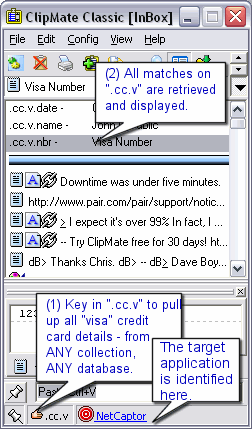

Once your data is in ClipMate, you can select an item and it is automatically placed back on the clipboard or directly into the application you were using.
CLIPMATE RESET WINDOWS
The cut/copy paste capability of Windows works well for transferring single items of data, but is not useful if you want to move a lot of data or keep data longer than until your next cut or copy (at which time Windows overwrites the clipboard whether you were ready or not!).ĬlipMate works alongside the regular Windows clipboard and remembers every piece of data (both text and graphics) that you cut or copy. Looking for a Better Alternative to ClipBook? - Check out ClipMate!ĬlipMate enhances the Windows clipboard, making it a true power tool. However, you can still use Clipbrd.exe to view the Local Clipboard. If you choose to keep this service Disabled, be aware that remote access will not be available to you to send and receive Local ClipBook pages of data.
CLIPMATE RESET MANUAL
However, you may want to set it to Manual if you use your Local ClipBook often and want to send and receive pages of data from others on your network. In addition, this service does pose a security threat to your computer by allowing remote computers access to your data. It is very hard to think of an example of when you would want to use this service since there doesn't seem to be a time that someone would need to access your Local ClipBook, unless you Copy and Paste a lot of data that another person would crucially need. Since this service is Disabled by default, it is recommended that you keep this service Disabled. The ClipBook service, when enabled on two or more networked computers, is responsible for sending these pages of data over the network. You can even share your Local ClipBook pages with other people on your network who have the ClipBook Viewer installed, which is where the ClipBook service comes into play. You can then use these pages to copy the contents back to the Clipboard and use in other documents or programs that support the use of the Clipboard. Every time you save a Clipboard file, it is stored as a page in the Local ClipBook. You can use the ClipBook Viewer to save the contents of your Clipboard to a file for later use.

The Local ClipBook window shows you the contents of your Local ClipBook. As you know already, the Clipboard window allows you to see the current contents of your Clipboard. Within the ClipBook Viewer in Windows 2000, there is a main window with two sub-windows called Clipboard and Local ClipBook. The ClipBook Viewer in Windows XP lacks advanced features, like Local ClipBook. Be aware that if you have Windows 2000, ClipBook Viewer will give you many more options and features than the ClipBook Viewer in Windows XP. Once you are in the ClipBook Viewer, you have many features and options available to you other than simply viewing your Clipboard. In order to access the ClipBook Viewer in Windows 2000/XP, you can type clipbrd in the open field of the Run option under Start. (This document will only discuss the ClipBook Viewer in Windows 2000/XP.) In order to alleviate this problem, Windows provided us with a Clipboard viewing utility called Clipboard Viewer in Windows 98/ME and ClipBook Viewer in Windows 2000/XP. Sometimes it's easy for us to forget which data is currently in the Clipboard, so we wind up pasting the wrong data into our documents. Whenever you copy or cut data, it gets stored onto the Windows Clipboard temporarily until you paste that data into a document. As you probably are already familiar with, Windows allows you to copy, cut, and paste text and graphics to documents using the Edit option. ClipBook works through the ClipBook Viewer so let's delve a little deeper into what this is and how it works.
ClipBook is a service that supports the ClipBook Viewer in creating and sending pages of text/graphics over a network to be seen by remote computers.


 0 kommentar(er)
0 kommentar(er)
